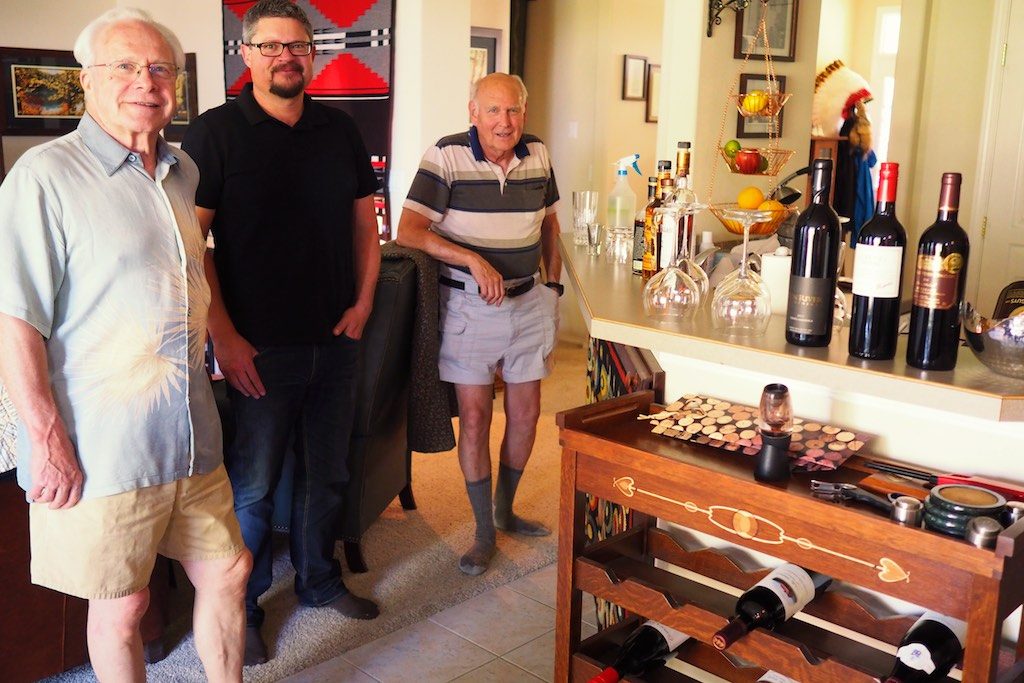
Center: Andy Moore.
Andy Moore traveled all the way from Australia to Seattle for a work-related conference, and while in the Emerald City, Andy made a 400 mile plus side trip to stop by Jeff's Place for a visit.
It was a pleasure and true honor to meet Andy and get to know him, and I'm so glad Andy was able to stop in for a visit!
Andy is passionate about the audio hobby, is a genuinely nice guy, has great taste in audio gear and music, and has thought long and hard about what he wants from this wonderful hobby.
One of the main thrusts of 2021 here at Jeff's Place is Peter Qvortrup's and my efforts to develop a more well-balanced, complete, and fair audio vocabulary to describe what we hear when listening to and evaluating an audio system.
The idea is to develop a vocabulary that takes in the different aspects of audio performance perspectives that we hear from the perspective of a manufacturer, audio writers, audiophiles, music lovers, music historians, studio engineers, audio dealers, custom audio builders, the DIY community, and just generally all the audio enthusiasts from whatever stream of audio they might come from that can offer insights into nudging our incredible audio hobby forward in a positive direction.
As a music and audio enthusiast, I asked Andy if he would tell us a little about his current audio system, what he likes about its performance, and then tell us about the vocabulary he uses for articulating its performance, and what he listens for when evaluating his audio system's performance.
Andy's Audio System
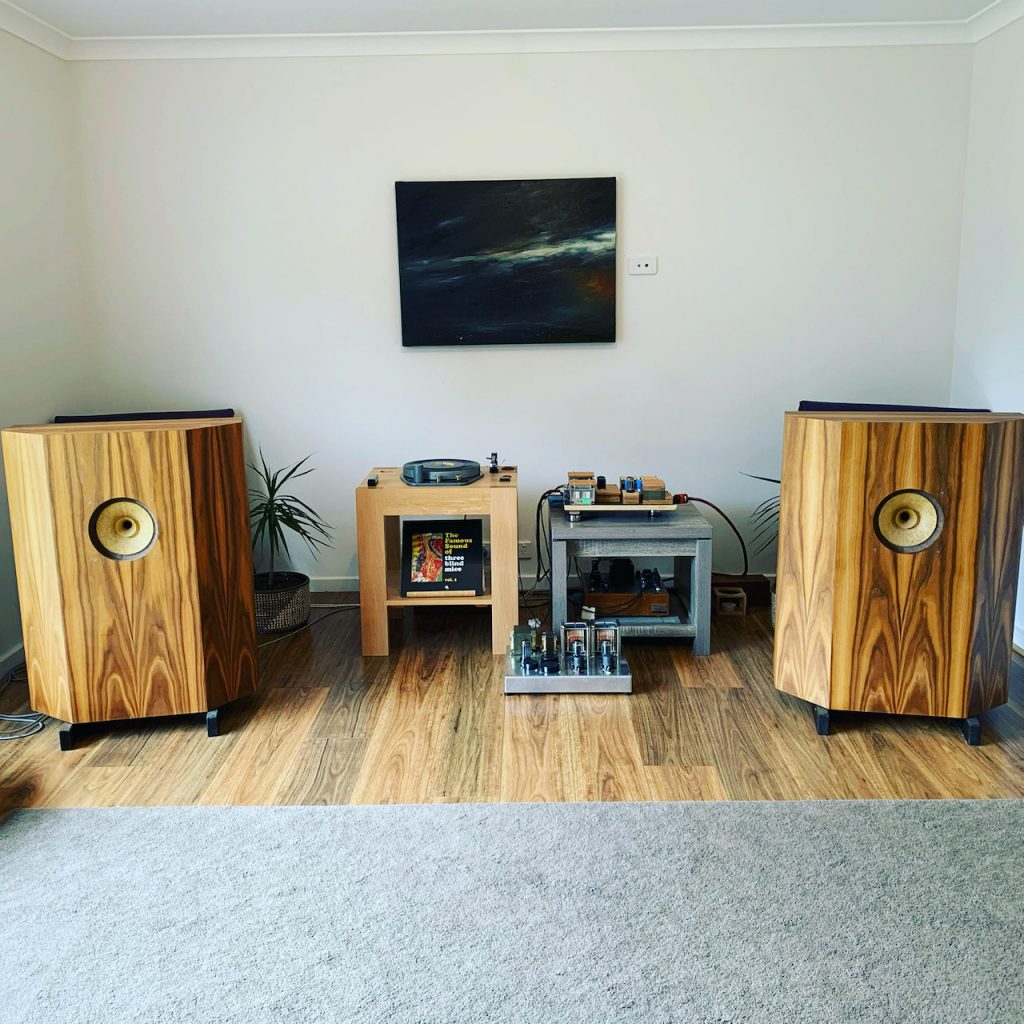
System photo of Andy's exotic audio system! Beautiful!
My audio system has been developed over a long period by listening to a lot of components, experimenting with different approaches and figuring out what sounds more real to me. After all I built the system to sound good to me, not anyone else. Many of the ideas above have come from a close group of friends that have taken a similar approach. I have been very fortunate to have advice from some very clever people who care deeply about music and its reproduction. I am forever indebted for all they shared and in helping me to build this system. I hope what I have written here helps you as their advice helped me.
My system philosophy is that I want my system to sound as natural and live like as possible. I use valves and transformers throughout (no transistors or op amps), point-to-point wiring, valve rectification with the best transformers and valves I can find. Maintaining dynamics, coherency and low-level resolution is very important to me, so all the circuits are as simple as possible with the finest parts. Every component and part that comes into my system gets evaluated under the same criteria. Does it sound more or less like real humans are making music in my room or at a live event. If it doesn’t meet those requirements it get sent on its way. This system will clearly show the effect of everything you put in the system, from a single resistor, to a few centimetres of different wire or a different IEC socket. And in every case those changes are never hard to hear.
I have removed all brass from the signal path. Lastly the system must play well at low volumes as well as loud. I have a family so I need a system that doesn’t need to be blasted to sound great, but I also like to listen at realistic levels when I can. I try not to use coupling caps and as few resistors as I can get away with. I use no crossover. There are no binding posts on my speakers. The connectors on the Rullit drivers were replaced with WBT Nextgen copper. Speaker wire runs from my output transformers to my drivers.
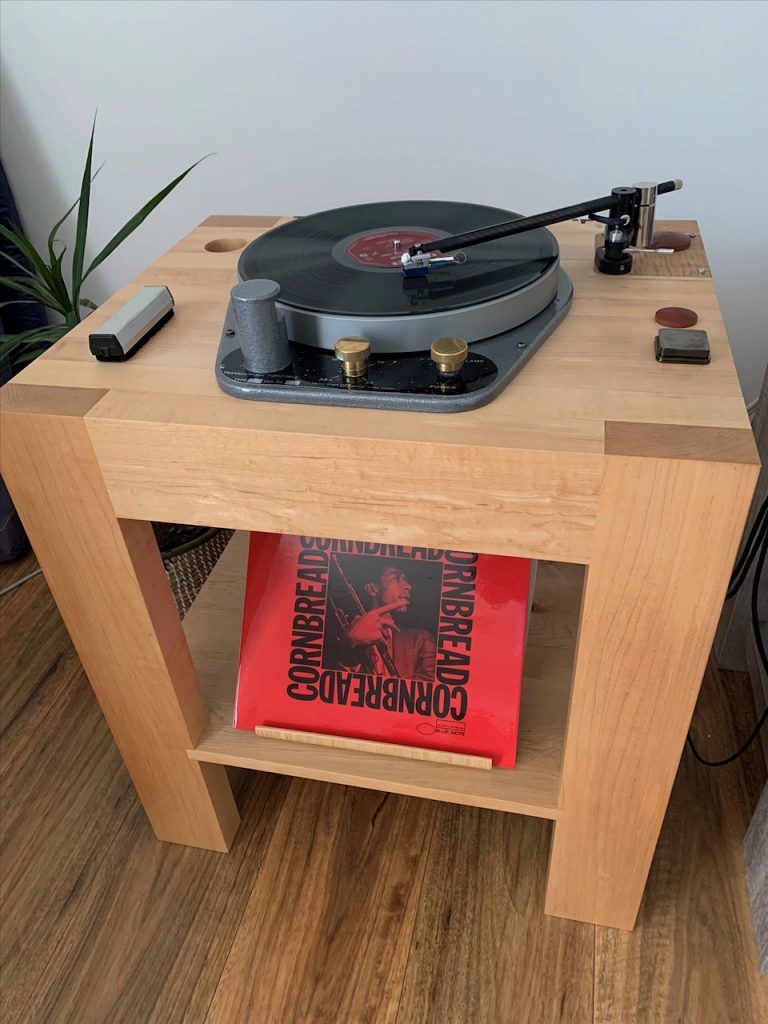
Commonwealth 12C idler turntable with Schroder CB tonearm.
For my analog front end I use a restored Commonwealth 12C idler turntable in a massive custom rock maple plinth/stand that I had made. I prefer idler turntables for the spirited and dynamic way they make music. The Commonwealth has a motor the size of a washing machine motor. It is a very lively, dynamic and weighty sounding turntable. The tonearm is a Schroder CB. Current cartridge is a vintage Signet TK3Ea with a new stylus assembly. I really like this cartridge for its spirited way with music, this is not a wimpy sounding cartridge on the Schroder. The Schroder has a single run of wire from the cartridge clips to the RCA plugs at the phono stage.
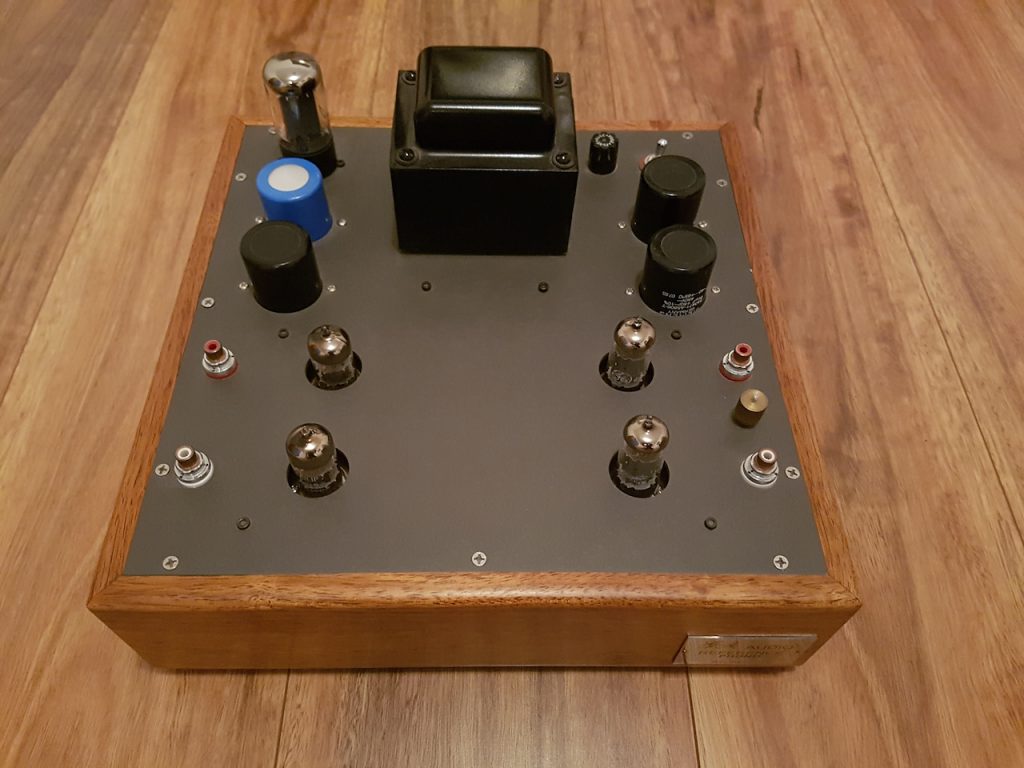
Golden Age Audio Reference phono equalizer by Due Min Lai.
My phono stage is a Golden Age Audio Reference made for me by my late friend Duc Min Lai. I use NOS Brimar Yellow T 6060, Mullard fat base GZ34 and Toshiba 6CG7 tubes. Input resistors are Audio Note 2 watt Niobium and coupling and output capacitors are Arizona Capacitor Blue Cactus. I replaced the IEC socket with Furutech NCF, a really worthwhile upgrade. This phono has been compared to many top phono stages and I prefer it to all I have heard so far.

Audio Antiquity prototype preamplifier by Misho Myronov.
My preamplifier is a prototype made by Misho Myronov of Audio Antiquity. This preamplifier is now made as a beautiful full production product called the Wooden preamplifier as it is mounted in a completely 3D wooden chassis. I wanted a very simple low-gain, single stage preamplifier built on the Siemens C3g. The C3g is a low noise pentode with a 10,000 hour life that was introduced in 1952. A single pair of C3g wired in triode is the only gain stage in the preamplifier. I see no need for multiple gain stages given the output of most sources. I love the purity of single gain stages. Signal path is very short and uses high quality 600 ohm output transformers and attenuation on the output via a fixed value Shinkoh resistor with excess gain shunted to ground via a pot. I mostly run the amplifier wide open of close to wide open so the pot is mostly out of the signal path, you are really only hearing the Shinkoh. There is a single input on the preamplifier as I don’t like switches in the signal path. RCA sockets are WBT nextgen copper. This simple approach along with very high-quality power supply (all transformers by Misho) maintains a very high level of resolution and dynamics. The only other resistor is being swapped to a 2 watt Audio Note Silver Tantalum or Niobium. Rectification is via a Mullard fat base GZ34. The preamp in mounted onto a wooden board while I get a new chassis made from American Walnut. The IEC socket is upgraded to Furutech NCF. As you can see form follows function with the preamplifier layout. Inputs and outputs are close together at one end and power supply at the other. The simplest implementation.
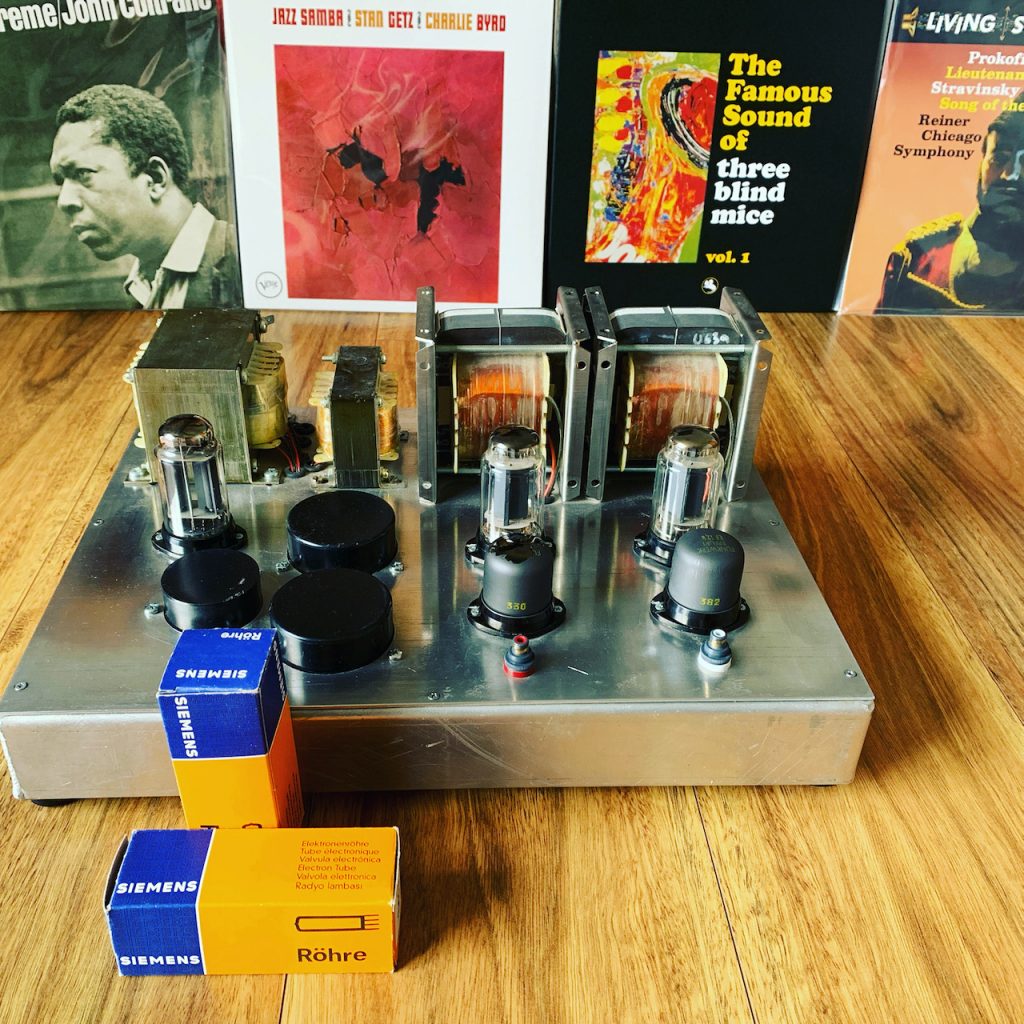
Prototype Audio Antiquary stereo amplifier by Misho Myronov.
My power amp is another prototype by Misho from Audio Antiquary, now in full production and called the Wooden amp. The driver tube is an EF12 pentode, (though currently being converted to E80F/EF86 pentode) wired in triode and interstage coupled to an EL12n pentode wired in triode producing 3.5 watts. All iron is by Misho and the output transformers are very large C-core. Rectification is by an EYY13 rectifier. RCA sockets are WBT Nextgen copper and binding posts are machined copper. Resistors are being changed to 2 watt AN Silver Tantalum or Niobium. A new chassis is being built at the moment and the IEC socket is being changed to a Furutech NCF. This is the most alive, dynamic amplifier I have heard and the resolution is amazing, without every veering into a clinical or etched sound.

Atelier Rullit Aero 8 field coil full range drivers by Oleg Rullit.
My speakers are Atelier Rullit Aero 8 field coil full range drivers built for me by Oleg Rullit.
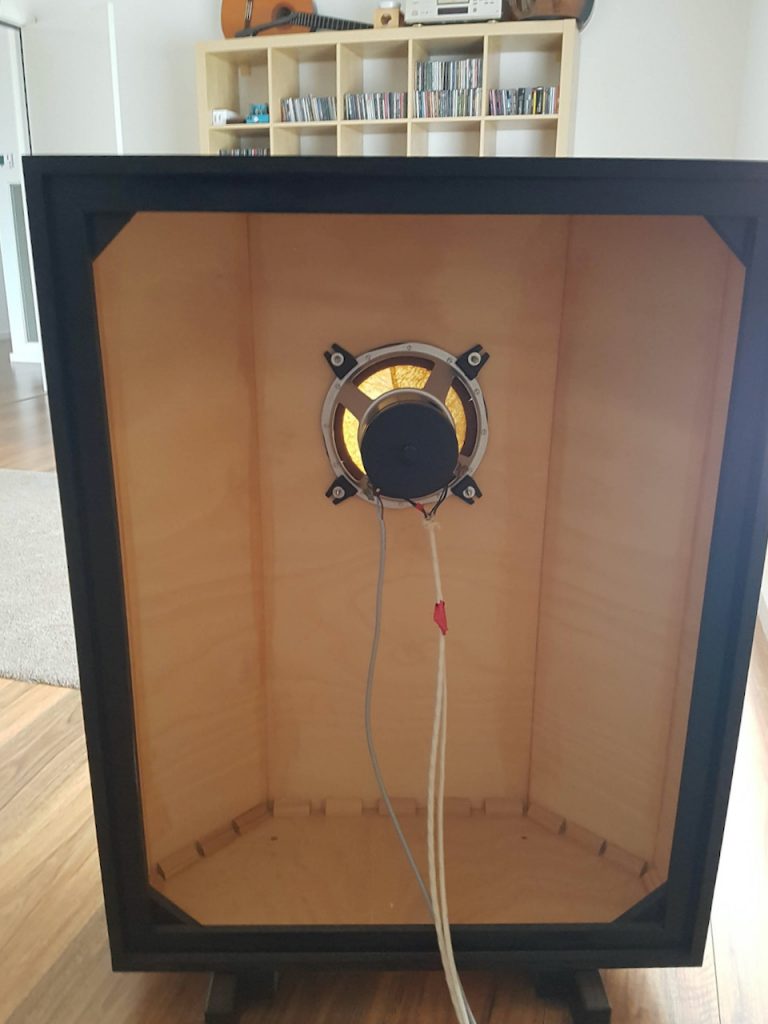
Rear view of the Siemens inspired open back baffles.
They are mounted in cabinets based on Siemens open back baffles built for me by a friend. I run the field coils at 130v in series so each driver sees about 65v. The speakers have no damping or bracing and use a resonant enclosure. This enclosure sheds energy very quickly and the rear wave of the driver can radiate into the room unadulterated. As a result this speakers doesn’t blur the sound like many box speakers. No back radiation through the driver, no energy bouncing around the enclosure continually blurring the mid-range and bass.
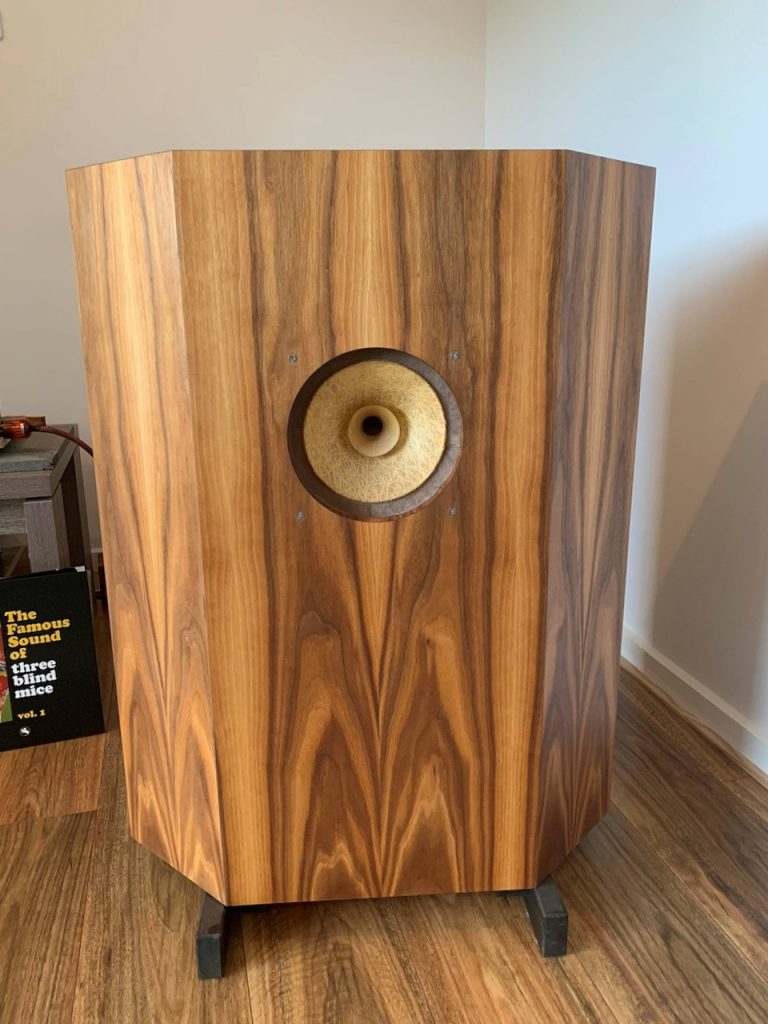
Front view of the Siemens inspired open back baffles.
The field coil is very pure sounding and natural. Many refer to this sound as water from a pure spring. The Rullit cones use a low mass material made from cellulose and rabbit fur that sounds very natural and does not have the typical papery colouration. The surrounds are made from very soft goat leather and the field coil motor is enormous.
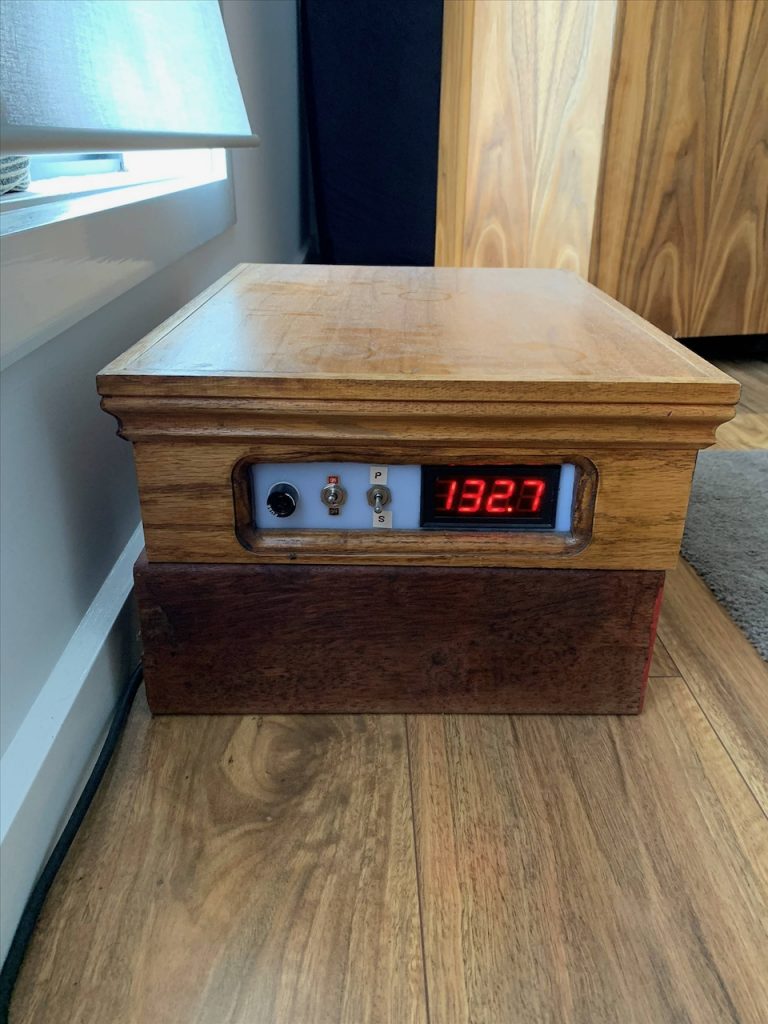
Field coil power supply for the Rullit drivers.
This combination of light stiff cone, light subtle surround and huge field coil motor gives explosive dynamics, ravishing natural tone and unlike many single driver speakers the Rullit’s (in the large baffle) have real bass and no presence region shout. I also find that these drives just don’t coagulate and compress on complex passages the way other drivers do. In the end these are the most live like natural speakers I have heard. But you need to use a very good source and amplification.
My interconnects are made from Gotham wire with KLE Innovations absolute harmony plugs and speaker cables are Auditorium 23 with KLE Innovations banana plugs. Power cords are KLEI GPower3 and Falls Audio.

System photo of Andy's exotic audio system in his dedicated listening room.
I am lucky enough to have a dedicated music room, for either listening or playing. I did the design and modelling of the room. It was built to best show off the Rullit speakers and has great acoustics. The room is isolated using double layer plasterboard with Green Glue acoustic glue to decouple the sheets. All wall cavities are filled with acoustic insulation. The wooden floor is laid over a concrete slab. There are twin commercial acoustic seals on the door frame, the door is solid core with a second layer separated by green glue. The room has two sperate power spurs from the mains box. I use heavy foam bass traps and a large record case behind the listening position. I will do more with room acoustics in the near future.
It's safe to say this is a very highly tuned custom setup. Everything in the system was built for me and has been tuned by me. The only things you can walk into a shop and buy are the Schroder tonearm (though you have to order them) and the power cords.
Many thanks to Andy Moore for telling about his audio system. Beautifully done, Andy! Now let's hear from Andy about the vocabulary he uses to articulate audio performance.
A Musical Language for Evaluating Audio Performance
This piece is an attempt to develop a more complete, nuanced, and meaningful language to describe the various attributes of audio gear. The idea came out of a discussion with Jeff, after his dialog with Peter Qvortrup over the last year. This is my attempt at developing this more indicative language and it something I have developed with friends so that we know exactly what each of us means when we describe a new component. I hope it is useful and helps with giving audiophiles and music lovers a more nuanced and descriptive language than we have to date. If you have your own descriptors that add addition nuance, I’d love to hear them.
What I read in so many audio reviews or hear from so many audiophiles is often a focus of the non-musical aspects of audio reproduction like black backgrounds, air and a focus on spatial information that are largely artifacts of the recording process. These aspects may be enjoyable but often they are prioritised at the expense of musical aspects of the reproduction. Trying to describe the sonic signature of a component or system by focusing on non-musical aspects like air, black background and spatial information is like trying to describe a beautiful painting by describing its frame. I found many of the descriptions used in audio provided little insight into the way something actually sounds. Therefore, working with some close friends we developed terms that we find far more descriptive.
I see many audiophiles that seem caught in an endless cycle of elation of reading a review about a new product, acquiring that product in the hope that it will fix their system, only to become depressed when it just brings more of the same. In speaking to many of these audiophiles they either can’t explain what they want to change in their system. What they want more or less of. They seem trapped in an endless cycle of churning through equipment. Though as a friend said recently, for some audiophiles this endless swapping game is what they’re chasing. It’s the rush of the new. Their joy comes not from the music but the purchase on the new component. Though I suspect most audiophiles and music lovers just want their system to sound enjoyable and to get out of the gear swapping cycle. Hopefully this article provides some additional language to describe what you are hearing and what you want more or less of, which is the real key to finding your audio bliss.
I would add one other piece of advice in building a musically satisfying system and that is develop your hearing. Make the time, understand what it is you are hearing and how it makes you feel, how your system makes you engage with the music or not. What you like and don’t like. Note it down. Once you have developed these skills, trust your ears. They are the only arbiter that matters. Not measurements, not the opinions of reviewers, manufacturers, or friends. Though it is useful to know someone who likes a similar audio aesthetic to you. The only people you need to please is yourself and your family. Choose things that make you happy, not what you read about as the latest and greatest.
This article is also a description of what I have learnt about various components, passive parts and circuits over the past few decades and the way they affect the sound. You may hear it differently, but hopefully you will gain something from it.
Wetness: This is a term that is particularly relevant to me and I find almost no one listens for it. As expected, it is the opposite of dryness and is particularly relevant to the human voice. I most often hear this as a wet sound that you associate with spit in voices, especially male voices. It is intrinsically linked to tone colour. A great example is when Satchmo sings, I can often hear the spit in his voice and the tonal weight of the big man in later years. It doesn’t sound that important but I find that a system that has great wetness and tone colour is far more in compelling to listen to that dry systems.
Causes: I find certain parts/designs remove this aspect from the performance, namely solid-state rectification, transistors, lots of feedback and metal film/metal oxide resistors. To my ears these tend to dry out the sound.
Live-like dynamics: This seems self-explanatory, but I find very few systems do this well, even for systems that are described as being dynamic. Most people associate loudness with dynamics. However, dynamics can be low level all the way through to loud and for me it is the speed at which a system reacts to musical changes. We are talking about transient response, the ability to respond to small changes in signal and to scale appropriately. There are several critical parts to maintaining live like dynamics. These dynamics are present in the best recordings, the secret is in letting it through rather killing them within the system. Using speakers with little or no damping material really helps, as does not trapping the rear wave only to have it bounce around the enclosure. The wave launch from the driver and enclosure are important. Also having speaker drivers, amplifiers and sources that recover the transient information. Large complex systems often kill these dynamics, its death by a thousand cuts…or solder joints, resistors, capacitors, switches, output devices, gain stages, etc. Complexity is the enemy of dynamics.
I find most narrow baffle multiway cone and dome box speaker don’t play live like dynamics particularly well and the less efficient the speaker the worse they do this. To my ear’s amplifier power can’t overcome the limitations of heavy cones with thick surrounds, weak pancake magnets and complex higher order crossovers. Once the dynamics are lost you can’t recover them. Using metal film resistors and ceramic drivers to give the sensation of resolution and dynamics doesn’t work, it just sounds artificial. The transient response of a high-quality high efficiency driver, either cone or compression, sounds so different from low efficiency drivers that are commonly used in modern speakers. High efficiency drivers have another advantage in that they can simpler single ended amplifiers, which for me exhibit faster transient responses that larger amplifiers. So far, I have only found the very best field coil drivers and horns to have this aspect in spades.
Causes: Box speakers with ported or sealed bass, heavy cone drivers with weak magnets, complex crossovers, the use of multiple output devices tend to blunt dynamics. Complexity and inefficiency are the enemy of dynamics, they both blunt dynamics and low level resolution.
Whack: This term is related to the mid bass. I find a lot systems sound dull and bloated with poor resolution and transient response within the mid bass. This relates to the type of driver used, it’s loading, the crossover and baffle step. To my ears trying to fix baffle step (so you can have skinny speakers that soundstage well) with a crossover has a real impact on mid-bass whack. I have found that I am very sensitive to this part of the frequency spectrum. What I miss in so many speakers is the hit from the mid bass that I hear in real music. It’s there in most types of music, but particularly old school blues and anything with drumming.

Front view of the Siemens inspired open back baffles.
The only solutions I have found that provide the mid bass whack (hit) of live music is field coil drivers in large open baffles and horn bass, especially front-loaded horns with high efficiency drivers.

Rear view of the Siemens inspired open back baffles.
Ported or sealed bass speakers just don’t get this right to my ears, no matter how much power is used. Getting this aspect of performance right contributes a lot to the overall impact of the music and how live-like it sounds.

Atelier Rullit Aero 8 field coil full range drivers by Oleg Rullit.
Causes: Narrow speakers, complex crossovers, box speakers, and heavy cone weak drivers, slow sounding amplifiers.
Harmonic resolution: Many people in audio use the term detail to describe the level of information a system can retrieve from a recording. What I find most people mean though is spatial information. I have heard a lot of systems that excel at retrieving spatial information but are relatively poor at retrieving harmonic information. The reproduction of the various parts of a note should be an easy thing to reproduce, but it’s far more difficult to do in a natural way. Harmonics are complex, nuanced and are vital to the portrayal of the musical event. There is a reason Guarneri or Stradivarius violins are so highly regarded and it’s because of their harmonic qualities. Getting this right means the difference between a Stradivarius and a Chinese copy.
Naturalness: This is something that is almost never discussed in audio but may be one of the most important attributes in providing a satisfying re-creation of a musical event. The one attribute that I hear in much of high-end audio these days is an artificial tonality, the music simply sounds synthetic and no longer real. Instruments don’t sound of themselves, but a new hyper-real synthetic recreation. I find this sound to be the very antithesis of engaging.
Causes: To my ears certain elements add to this creation. Inert speaker enclosures and especially speaker enclosure made from synthetic materials, ceramic and diamond coated drivers, metal film/metal oxide resistors, solid state rectification, too much silver in the circuit and systems that focus of removing all vestiges of harmonic distortion. I think it was Herb Reichert that said things sound like what they are made of and that is certainly what I hear. Synthetic materials produce synthetic tone. I can’t remember the last time I heard an audio system in a high-end dealer that didn’t sound artificial, and seemingly the more a system costs the worse it gets. The target of super high spatial resolution, super low harmonic distortion, airy highs and black backgrounds espoused by the high end is a dead end for many of us.
Tone colour and saturation: While tone is covered in some reviews, though hardly enough, tone colour is something that seems poorly understood. Outside of reviews by Jeff and the late Art Dudley, I don’t see much understanding or appreciation for this important parameter. Or what contributes to it or removes it. I liken it to taking a picture in the middle of a bright sunny day in a city landscape with lots of hard reflective surfaces, compared to a picture taken of a natural landscape early morning or late afternoon. The first picture is bleached of colour and looks bleak and harsh. The second picture has a light which brings out the natural colour of the environment. Not in an overdone colour enhanced way, but a natural way. While there are some systems that get several aspects of audio right, I find very few produce realistic tone colour. Tone colour is closely related to naturalness and the same things seem to affect both tone colour and naturalness. Again, an industry focus on reducing harmonic distortion and increasing spatial resolution has come at the expense of tone and contributed to the dominance of the artificial hifi sound.
Flow/liquidity: While this attribute is recognised in audio, it is an attribute often overlooked. I find that with the most enjoyable and foot tapping systems music pours out like water from a pipe. The music isn’t broken apart, it isn’t dried out or stark, it isn’t forced, it isn’t reticent or sped up, it has continuity of natural flow that pulls the listener in.

Commonwealth 12C idler turntable with Schroder CB tonearm.
This is one reason I enjoy idler turntables so much, they seem to plough through music complex passages with ease. I find the best single ended amplifiers do this as well as field coil drivers and some horns. Overly complicated circuits, negative feedback, a lot of complexity in the signal path or complex higher order crossovers often hinder musical flow.
Coherence/Gestalt: Coherence is something that is well discussed, but not something I hear a whole lot from many speakers. I am particularly sensitive to coherency in speakers and it is one of the main reasons I don’t like many multiway speakers. The difference between different driver types and materials is often easy to hear, as is time coherence and paints a musical picture which sounds fractured. I’m guessing others aren’t as sensitive to this as we wouldn’t see the proliferation of multiway speakers which is mainstream audio. For example, there are many designs that use ribbon tweeters crossed over to inefficient small cone drivers loaded in a ported box or a horn loaded compression driver with a low efficient ported or seal box.

Front view of an Atelier Rullit Aero 8 field coil full range driver.
Neither of these approaches sound coherent as each driver and loading sound very different from one another and the recreation of a coherent picture is shattered. I often find difficult to listen to anything beyond a well-designed two-way speaker. My current preference is for a single full range field coil driver in a large open baffle.

Rear view of an Atelier Rullit Aero 8 field coil full range driver.
Impact and scale: Many years ago, when I first got into audio one of the things that troubled me was the lack of impact I heard from audio systems. They sounded mild, small, weak, lacklustre, polite, hollow, and just downright boring. Sure, some could play loud, but without the impact of live music. Listening to any music with dynamics just sounded wrong. Real music sounds dynamic and has real impact, even a single acoustic guitarist or vocalist can have real impact, let alone a whole band or orchestra. This is an area that, while better than I remember it a few decades ago, there has seemingly been little progress. Many high-end audio systems can sound loud but lack impact. I hear this with a lot moving coil cartridges, they sound thin, hollowed out, tipped up and eviscerated. While some systems scale ok (some excessively so), they can still sound dull, slow and boring.
Intimacy: On the flip side of scale, some large speaker systems do a fair job at replicating scale, but often lack the ability to do small scale intimate music well. A single singer or small acoustic band sounds larger than life and lacks a sense of intimacy that coherent smaller systems excel at. I think we have all experienced the singer with a 10 foot head and it removes the believability of the reproduction.
Chunky: This attribute is something that I crave and really helps in my enjoyment and believability in musical reproduction. In a way it is the antithesis of many the thin, flaccid systems. These systems seem to trade off fullness for delicacy and refinement. The chunky sound is manifest when instruments have body, they sound solid and have a feeling that you could walk over and push the singer or musician over. They are not thin wispy holograms or ghosts, but real flesh and blood people. Their instruments sound believably chunky and made of real wood and brass. For example, my wife plays the oboe. It is an instrument that does not sound thin, wispy or weak. For the most part it sounds full and colourful, with great harmonic complexity.
Natural bass: I have covered naturalness and mid bass whack above, but this is an area that I find very few get right and so deserves its own description. I must admit that I just don’t like the way most speakers recreate bass, especially the mid-bass. Most just sound slow, boated and lacking resolution. The transient snap and kick is blunted, bass is ill defined and dull. No matter how many watts you drive inefficient drivers in a ported or sealed enclose with they just don’t sound real to me. The timing is often affected as well. Real acoustic bass simply doesn’t sound this way. Real bass sounds natural, with high resolution and dynamic nuance. It has real snap and impact. Hifi bass loads the room in a way that might impress your friends but to me never sounds natural.
The way of producing bass that sounds most natural to me is high efficiency field coil drivers in large baffles. Not just any drivers, but drivers that have the correct Qts to be used in open air. These drivers don’t need air compression provided by a box to push the driver back into position. And they don’t need high damping solid state amps to control the driver. In fact, if you use high damping on these drivers they sound dry and mechanical. The high magnetic force produces all the damping they need.
In an open baffle configuration the energy from the driver can radiate rearwards into the room allowing all the resolution to come through naturally, not be trapped in a box where it now creates problems. I don’t use damping of any kind or bracing and don’t use inert speaker material. Damping material kills dynamics. Why create output only to try and kill it in the rear wave? When you that that energy free it doesn’t bounce around the box or back through the cone causing smearing. Having a driver that has an open basket and not blocked by bracing or damping is critical hear too. Used in an appropriately large baffle to all but eliminate cancelation, these drivers sound so natural and unstrained, so fast with amazing natural resolution. The first time I heard field coils in open baffle (Shindo) was a revelation. All the things I didn’t like about box speakers were absent, bass and mid bass sounded natural. However, use these drivers in a narrow baffle (to help with imaging) and you lose the mid-bass snap and kick, something crossovers can never put back. Well implemented horn bass can produce the same dynamic punch and resolution.
Causes: Causes of non-natural bass are drivers with heavy cones and surrounds, weak magnets, ported or sealed bass enclosures, damped encloses and inert speaker cabinets.
Compression/coagulation: We all know about dynamic compression in modern recordings, but system can bring their own dynamic compression. I hear dynamic compression, especially with heavy cone drivers with small magnets, as a loss of resolution and a coagulation of the sound when the music gets complex. Often it is accompanied by a hardness and strain and the driver simply can’t maintain composure when the music gets complex. I also find that turntables with weak motors, typically belt drives contribute to this as well. The best idler drives seem to sail through complex musical passages, where I find many belt drives compress the music. Complex amplifiers with multiple output devices also tend to do the same thing, or single-ended amplifiers with poor driver stages and transformers. The very best single ended valve and solid-state amplifiers just don’t coagulate when used with appropriate speakers.
Grain: I think most of us understand grain when it’s excessive. But is it often present in complex amplifiers, especially high powered solid state (class A/B or B) and of course in turntables that aren’t very well setup. A significant contributor to listener fatigue.
Etch: Etched sounding systems are those that are overly crisp, sharp and excessively focussed. The music sounds artificial. Quite the opposite of natural and organic. Metal film and metal oxide resistors bring out this characteristic as do ceramic drivers and designs focussed on having the lowest harmonic distortion. I have heard a lot of systems with this etched sound and I find it is one of the major causes of listening fatigue.
Hollow: Some systems and components seem to have suck out in the midrange giving them a hollow ghostly sound, which at is worst has gives a thin wispy artificial holographic sound. This can be caused by phase issues with the speakers. Speaker setup can help. Some moving coil cartridges can emphasis this type of sound, with a suck out in the mid-range and tipped up high frequencies.
Mechanical: Mechanical sounding system tend not to sound coherent and have natural flow. The music does not gel or sound natural. Think robots playing music.
Ease: That sense that music is presented in a natural way, it is not forced but just happens. I find speakers with ported bass have a way of producing bass and loading the room that sounds strained. A system that has great ease with all musical types is such a joy to listen to. The opposite of listener fatigue.
Natural soundstage: I do not place sound staging as the highest priority like many audiophiles. I want the stage to sound natural and commensurate with the recording. What the best systems do is create a soundscape where people sound natural, present, whole, solid and three dimensional. With three dimensional I don’t mean the normal three-dimensional soundstage; I mean people in the soundscape sound three dimensional. They have a front, a back and a solid bit in between.
Immediacy/presence: As someone who loves single ended amplifier designs it’s no secret that I prefer a system that great immediacy. Simple single ended amplifiers and single driver system just excel at immediacy. The sense that there is nothing between you and the singer/musician. They are reach out touch it real. I would add that this is one area (and there are many) where the best field coils come into their own, they have a purity that is addictive, and it increases immediacy substantially. It’s only when I listen to speakers with crossovers and complex amplifiers do I realise what is lost.
Cause: I find that complexity hampers the sense of immediacy and presence. Every part in the system, every solder joint, every plug, socket and switch, every resistor and capacitor alter the signal. They blunt dynamics and reduce resolution and presence. Eliminating complexity can have great gains in musical presence.
Weight: The other key to natural sounding bass is weight, fullness and gravitas. Bass weight is both a function of the speaker implementation, how the system is tuned and of course the acoustics of the room. I have heard countless systems that have extension into the 20Hz range and deeper but have neither mid-bass kick or weight. Tuning a system to have fast clean nuanced bass without bloat while having weight is a real challenge. If you your is small to medium size it is likely to cause problems in the bass (60-250Hz) region. Unless you are lucky enough to have a large room with good dimensions you will have issues in this area. You are will have a fundamental room resonance, the frequency of which depends on your room dimensions and a harmonic which is double the fundamental. Additional harmonic resonances are likely to affect the mid bass as well.
If the room in untreated in the lower frequencies, you will struggle to get good extension and weight that doesn’t sound bloated. It’s better to have less bass than bad bass. And yes you can have a system that has dynamic kick and bass weight that only goes down to 40-50Hz. Remember bass is 60-250hz and kick/whack comes from the mid bass at 250-500Hz.
By selecting components, power cords and passive parts carefully you can tune your system to have more natural weight. Greater weight and fullness is apparent in most music but particularly with piano and your systems sense of scale. It is also the difference in where you hear a singer’s voice come from. I don’t mean spatially. I mean do you hear a wonderful singer like Satchmo sound like his voice emanates from his head or do you hear it come from much deeper. Satchmo was a big man with a big voice. That big cavity is easily audible on a system with great weight. The music sounds like it comes from deep down in that big cavity. It sounds full, weighty with gravitas and hopefully wetness. On many speakers it sounds like Satchmo is small with his body removed. I find that systems with great natural weight are far more compelling and easier to listen to that ones that have greater extension.
Causes: Narrow speakers, narrow open baffles are particularly susceptible, small drivers, thin sounding components and parts.
Tyranny of the frequency extremes: Art Dudley wrote about the tyranny of frequency extremes. What he meant (as I understand it) was that many audiophiles focus of frequency extension at the expense on the music. They chose components that have great specs, especially with regards to the frequency extension or distortion measurements, often assuming that if a component has better specs and goes lower or higher it has to sound better. Rarely is this the case. Much of the emotional connection to the music comes from the mid-band and the mid bass. Get that part right and you can connect to the music irrespective of a lack of frequency extension. Get it wrong and it won’t matter how high or low the system plays, it will be difficult for the listener to connect with the music. And that’s kind of the whole point, at least for me. I find that if a system stimulates me cerebrally rather than emotionally, I lose interest very quickly. It’s the same for coherency. Get that wrong and the system will for the most part sound like a bunch of parts working out of unison.
I would like to thank Andy Moore for telling us about his audio system and the insights into performance he has realized through building and listening to music with it.
Audio systems are very personal expressions of the performance elements we value while listening to the music we love, and new revelations into performance can result as we explore new - or old - realms of design, materials, system implementation, and new genres and eras of music from our recorded music canon.
For those who build systems from scratch like Andy has, there is a lot of joy associated with shaping the presentation of the music we love through carefully selected components, from source to loudspeakers.
Many thanks to Andy for taking time to thoughtfully go through the vocabulary he uses to articulate system performance.
We are all enthusiasts of audio and music, and to get a deeper glimpse into what you truly value in this wonderful hobby, I encourage you to listen to and "feel" the performance of your own audio system, and to try to articulate in your own words how you would describe its performance in terms of what you hear and feel, just as Andy has. What is the vocabulary you use to articulate performance?
This can be quite a challenging exercise to go through, and it will give you a glimpse into why we need a more complete way to articulate audio performance.
You will learn a lot about what you value in a high-fidelity music system, what you want to hear from it, and how you want it to make you feel while listening to your favorite music.

The Phantom of the Opera at Her Majesty's Theatre in London.
Consider what you hear and feel when listening to a live music experience.
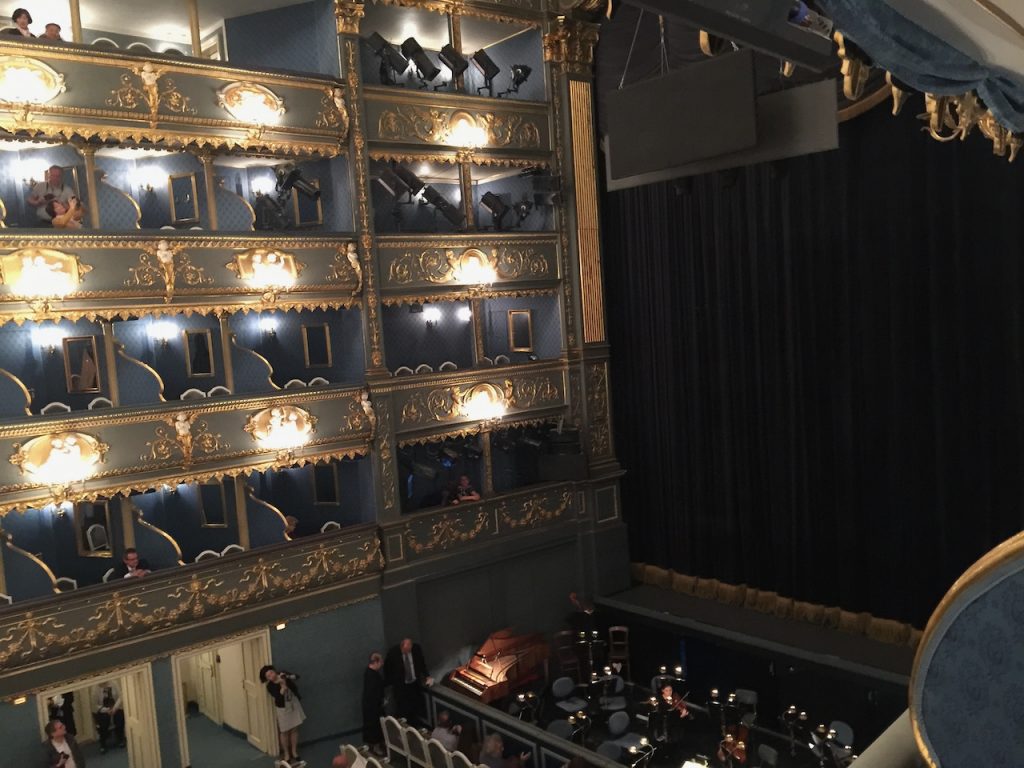
Marriage of Figaro at the Prague National Theatre.
What you hear and feel while attending the Phantom of the Opera at Her Majesty's Theatre in London is a very different experience from what you hear and feel when attending the Marriage of Figaro opera at the Prague National Theatre.
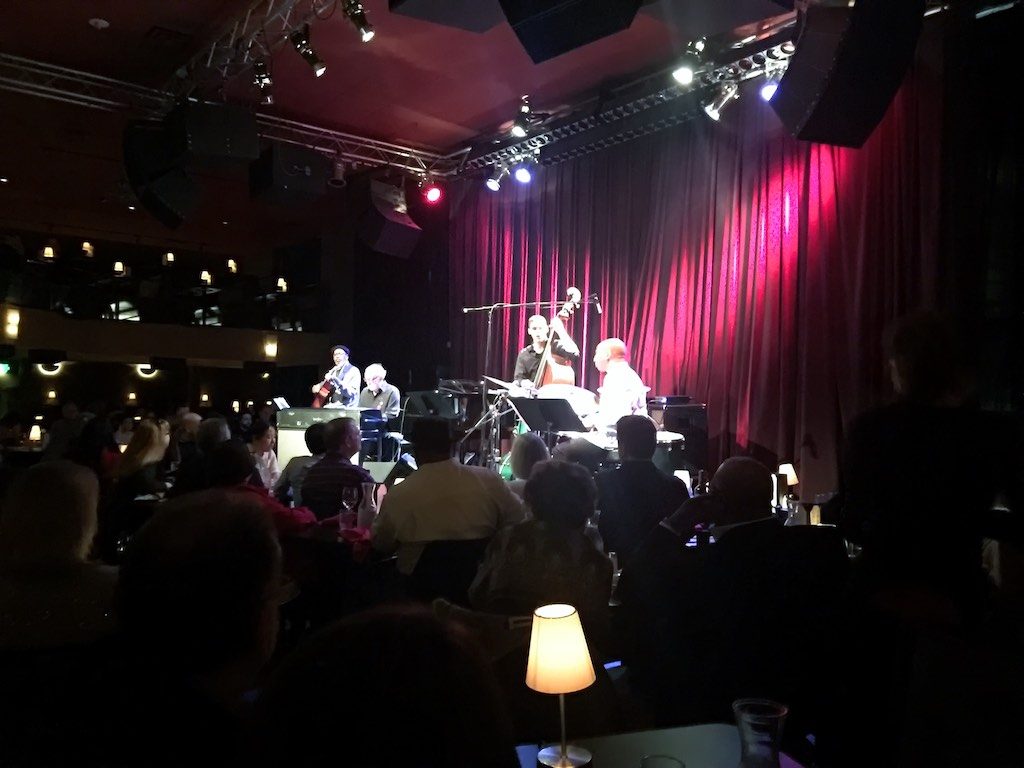
The Bob James Quartet live at Jazz Alley in Seattle.
What you hear and feel while listening to jazz at Jazz Alley in Seattle or the Jazz Club Reduta in Prague is a very different experience from from what you hear and feel from live blues music in the Checker Board Lounge in Chicago.
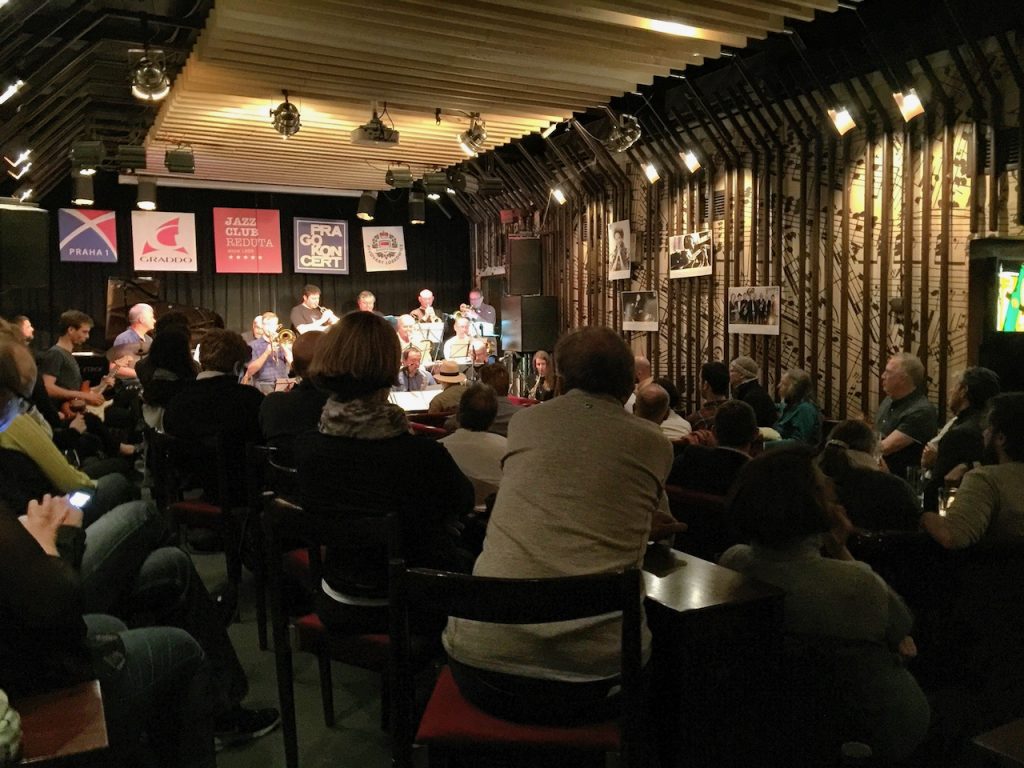
Jazz Club Reduta in Prague.
Experiencing bluegrass music at the Tractor Tavern in Seattle sounds and feels very different from what you hear and feel listening to soloists and ensembles playing Mozart in a Salzburg Palace concert.
I think you get the idea, listening to live music is a variable, exciting, beautiful, and diverse experience, with each musical performance being a unique and rewarding artistic experience.
All of those above examples of live performances I've personally attended and enjoyed, and they were all very different in terms of what I heard and felt while experiencing them, and I loved experiencing every one of them.
Now consider listening to your own audio system. How does it compare to what you heard and how you felt at that live performance you experienced?
You do have to factor in that all of the recorded music you listen to are going to necessarily sound and feel different than live music because they are completely different and unique forms of enjoying performances of music.
An album of recorded music is an artful collaboration between the musicians and those recording, mixing, mastering, and producing it for sale, and it is necessarily different from what you hear and feel when attending a live performance, and that's ok.
When you are listening to a recording of music how does what you hear and feel from the experience compare to that live music experience? What words would you use to articulate those differences?
In closing, I'd like to once again thank Andy for sharing with us about his audio system, what he hears from it, how it makes him feel, and the vocabulary he uses to articulate it. Thank you, Andy!
As always, thanks for stopping by, and may the tone be with you!



























